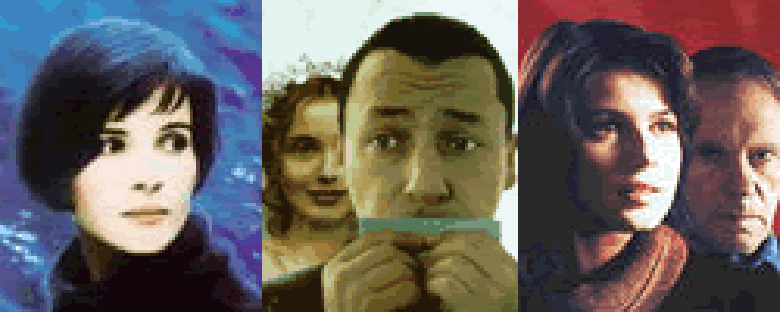Credits
Feature by: Rumsey Taylor
Posted on: 17 July 2004
Related articles:
reviews: Three Colors: Blue
reviews: Three Colors: Red
reviews: Three Colors: White
Polish filmmaker Krzysztof Kieslowski’s first film to gain international recognition was 1979’s Camera Buff. In it a family father buys an 8mm camera to film his new child. The man becomes increasingly fascinated with the device and begins filming his family, friends, and coworkers. This practice has earned him the position as an objective overseer of life, as he captures the incident of others’ existences.
When viewed as an introduction to Kieslowski’s later films, Camera Buff illustrates the critical strength of the director’s gaze; like his protagonist in Buff, Kieslowski films actions at occasion, and in turn his work is reveled for exposing life’s inherent coincidences and ironies.
This is most defendable in the filmmaker’s cumulative effort, the “Three Colors” trilogy: Blue, White, and Red. Each film was released in succession, beginning in 1993, and each may be viewed singularly according to its own freestanding merit. When viewed in whole, “Three Colors” is seen as a single motion: certain actions repeat in each film and each borrows or builds upon themes introduced in its associated sequels. It may be lofty to claim that connections in “Three Colors” elevate the significance of the trilogy as a whole, though contending that their correspondence is deliberately coincidental (and pointless) is less defendable.
“Blue is a gorgeous film, dramatic and tragic. It is worthy of being measured by its own singular worth. However, only when viewed as the opening of Kieslowski’s “Three Colors” does it garner further meaning …”
*
The trilogy, in its contemporary understanding, has certain conventions. A trilogy is mostly produced in action or horror, and in both cases is a fragile umbrella that obliges three films known better for their individuality rather than their cumulative whole.
Krzysztof Kieslowski’s “Three Colors” only suffers from this Hollywood understanding of the trilogy. The films are distinguished not for their singularity but for their connection.
The Polish director’s most heralded effort prior to “Three Colors” was The Decalogue, a series of short films based in whole upon the Ten Commandments. It has come to be regarded as one of the most heralded cinematic achievements in history.
The conceptual basis of The Decalogue is furthered in “Three Colors,” as each film is based upon a color in the French flag, and furthermore, each color’s political connotation. As with Blue’s liberty, in White Kieslowski approaches the concept of equality according to both political and personal grounds.
“Equality in White is used in the sexual implications of Karol’s marriage; their sex is denotative of their equality. In their divorce trial, Dominique cites his inability to consummate their marriage as ground for her disinterest, and finally their divorce. Karol eventually manages to bed Dominique, and her climax (easily, one of the most powerful orgasms depicted in film) is represented by a brilliant flash of white on screen.”
*
In response to Red, in what is the most enthusiastic film review I have read, Roger Ebert writes, “To fully understand how accidental and random life is — how vast the odds are against any single event taking place — would be humbling.” This, he appropriately claims, is one of the distinguishing qualities of Red. His excited praise is contagious.
Once seen in whole the consistencies in “Three Colors” do well to cohere the three films. The trilogy is a high-art concept that intends to cite the irony of its source. Fashioning filmic equivalents to the French tricolor is a pretentious task Kieslowski has admitted. He has instead shown how liberty, equality and fraternity, each denotative of a collectively-sought virtue, are redefined once regarded on an individual level.
Loosely confined beneath the ceiling of fiction, “Three Colors” — both the collective and individual relevance of its political make up — is a highly rewarding if not beneficial viewing experience.
Red ends with a cataclysmic event that gathers the characters from each film in one, final stroke. In this phenomenal occurrence it is evident that the fabric of existence responds to even the slightest disruption. “Three Colors” is much like the mechanism of life itself.
“Red opens with the image of a hand picking up a phone and dialing numbers. The camera pans and follows the cord into the wall, down the street, into and across the English Channel, and ultimately to another phone in France. Complimenting this sequence are the voices of other simultaneous conversations. This sequence embodies the underlying mechanism in Red, as it exposes the connections people share with each other, however brief and unknown.”
We don’t do comments anymore, but you may contact us here or find us on Twitter or Facebook.



